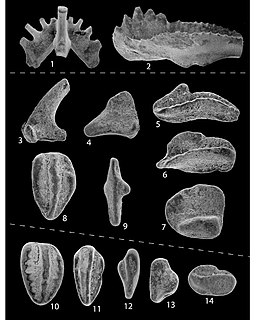Related Research Articles

Conodonts are an extinct group of agnathan (jawless) Fish resembling eels, classified in the class Conodonta. For many years, they were known only from their tooth-like oral elements found in isolation and now called conodont elements. Knowledge about soft tissues remains limited. They existed in the worlds oceans for over 300 million years, from the Cambrian to the beginning of the Jurassic. Conodont elements are widely used as index fossils, fossils used to define and identify geological periods. The animals are also called Conodontophora to avoid ambiguity.

Promissum is an extinct genus of conodonts, primitive chordates, that lived during the Upper Ordovician period.

Hindeodus is an extinct genus of conodonts in the family Anchignathodontidae. The generic name Hindeodus is a tribute to George Jennings Hinde, a British geologist and paleontologist from the 1800s and early 1900s. The suffix -odus typically describe's the animal's teeth, essentially making Hindeodus mean Hinde-teeth.

Archeognathus is a fossilized jaw apparatus of a large predatory conodont from the Ordovician period. Its large size has made classification difficult, and it has historically been compared to conodonts and gnathostomes since its remains were first discovered in Missouri. Complete articulated jaw apparatus of Archeognathus primus are common in the Winneshiek Shale lagerstätte of Iowa, allowing its identity as a conodont to be secured.
Prioniodontida, also known as the "complex conodonts", is a large clade of conodonts that includes two major evolutionary grades; the Prioniodinina and the Ozarkodinina. It includes many of the more famous conodonts, such as the giant ordovician Promissum (Prioniodinina) from the Soom Shale and the Carboniferous specimens from the Granton Shrimp bed (Ozarkodinina). They are euconodonts, in that their elements are composed of two layers; the crown and the basal body, and are assumed to be a clade.
Wurmiella is an extinct conodont genus.
Spathognathodontidae is an extinct conodont family ranging from the Silurian to the Devonian.
Ozarkodinida is an extinct conodont order. It is part of the clade Prioniodontida, also known as the "complex conodonts".
Ozarkodina is an extinct genus of conodonts in the family Spathognathodontidae.
Spathognathodus is an extinct conodont genus in the family Spathognathodontidae. It is a non-Platform conodont, from the Pennsylvanian (Carboniferous).
Lanea is an extinct conodont genus in the family Spathognathodontidae from the Early Devonian.
Idiognathodus is an extinct conodont genus in the family Idiognathodontidae.

Gnathodus is an extinct conodont genus in the family Idiognathodontidae.
Distomodus is an extinct genus of conodonts.
Metapolygnathus is an extinct genus of platform conodonts.

Histiodella is an extinct genus of conodonts.
Protohertzina is a genus of conodonts or, possibly, Chaetognaths, found at the beginning of the Cambrian explosion.

Oncodella is an extinct genus of Late Triassic conodont. The genus was given the type species Oncodella idiodentica by Mosher (1968), on the basis of fossils from the Late Triassic of Austria. However, Mosher (1969) later revised the species name to Oncodella paucidentata, since identical fossils from the same area were previously given the name Hindeodella paucidentata by Mostler (1967).
Parvigondolella is an extinct genus of Late Triassic conodonts. The most common species in the genus, Parvigondolella andrusovi, is used as an index fossil for part of the Sevatian substage of the Norian stage. Kozur & Mock, 1991 named two additional species, P. rhaetica and P. vrielyncki. Moix et al. (2007) later argued that "Misikella" rhaetica was a species of Parvigondolella. In order to prevent having two different species with the same name within the genus, they renamed Kozur & Mock (1991)'s P. rhaetica to P. prorhaetica. However, this would be unnecessary if "Misikella" rhaetica was not related to Parvigondolella. Parvigondolella is typically considered a direct descendant of Mockina/Epigondolella bidentata.

Panderodus Is an extinct genus of jawless fish belonging to the order Conodonta. This genus had a long temporal range, surviving from the middle Ordovician to late Devonian. Recently, extremely rare body fossils of Panderodus from the Waukesha Biota were described, and it revealed that Panderodus had a more thick body compared to the more slender bodies of more advanced conodonts. It also revealed that this conodont was a macrophagous predator, meaning it went after large prey.
References
- ↑ On Classification of Pridoli (Silurian)-Lochkovian (Devonian) Spathognathodontidae (Conodonts). MA Murphy, JI Valenzuela-Ríos and P Carls, 2004